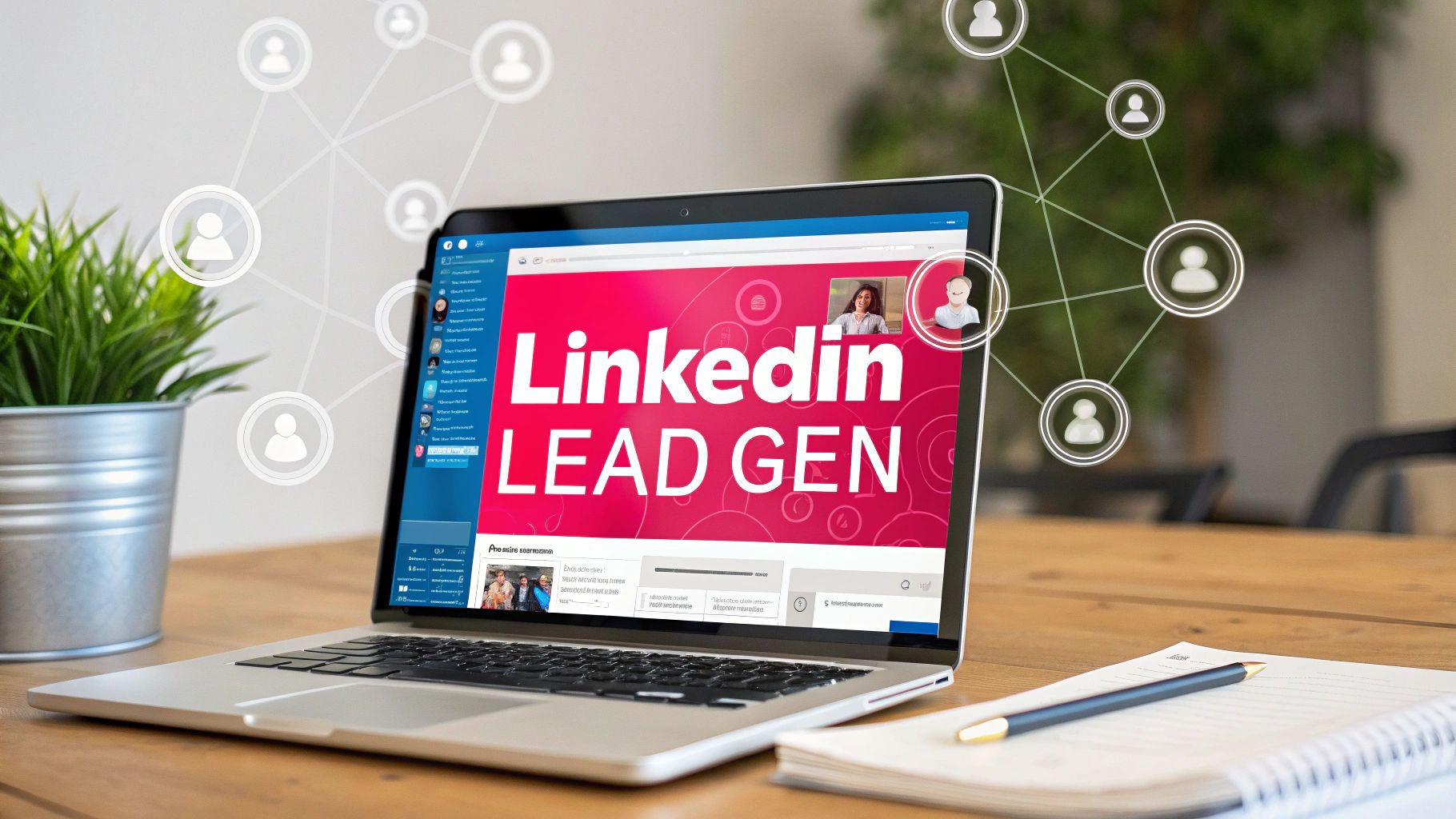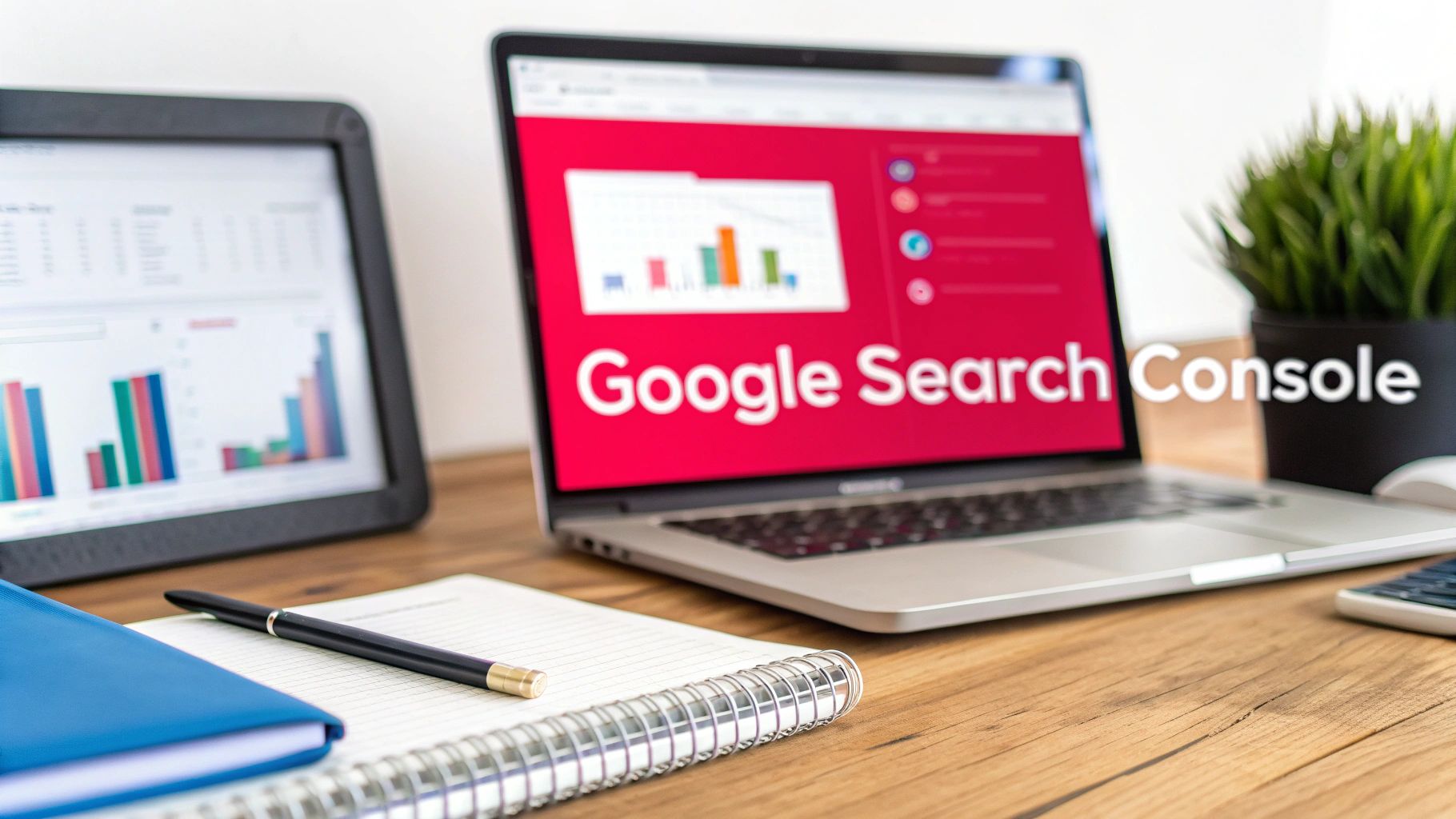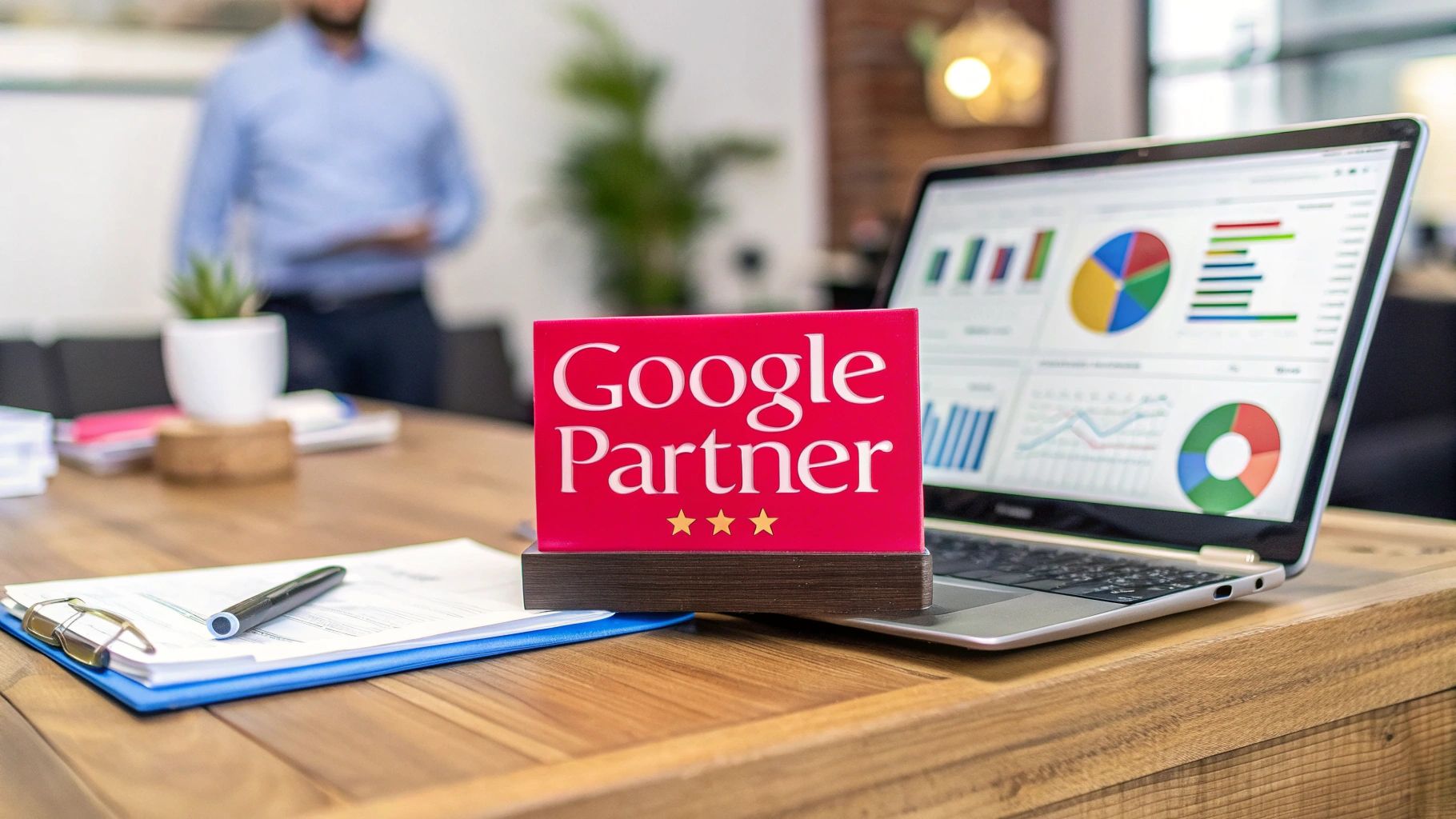Before you even dream of sending a single outreach message, we need to talk about your LinkedIn profile. Think of it less like a digital resume and more like a finely tuned machine for attracting clients. It's your strategic home base, built to speak directly to your ideal customer's biggest problems and turn their curiosity into a real conversation. A strong profile isn't just nice to have; it's the bedrock of any successful B2B lead generation effort on LinkedIn.
Build a Profile That Actually Converts
Your profile is often the first impression a potential client has of you. It needs to do more than just list your job history; it has to immediately show how you solve problems. It's your digital storefront. If the window display is cluttered or confusing, people will just keep scrolling.
You want to stop them in their tracks and make them think, "Now this is someone who gets it." This means shifting your entire mindset from "Here's what I've done" to "Here's what I can do for you."
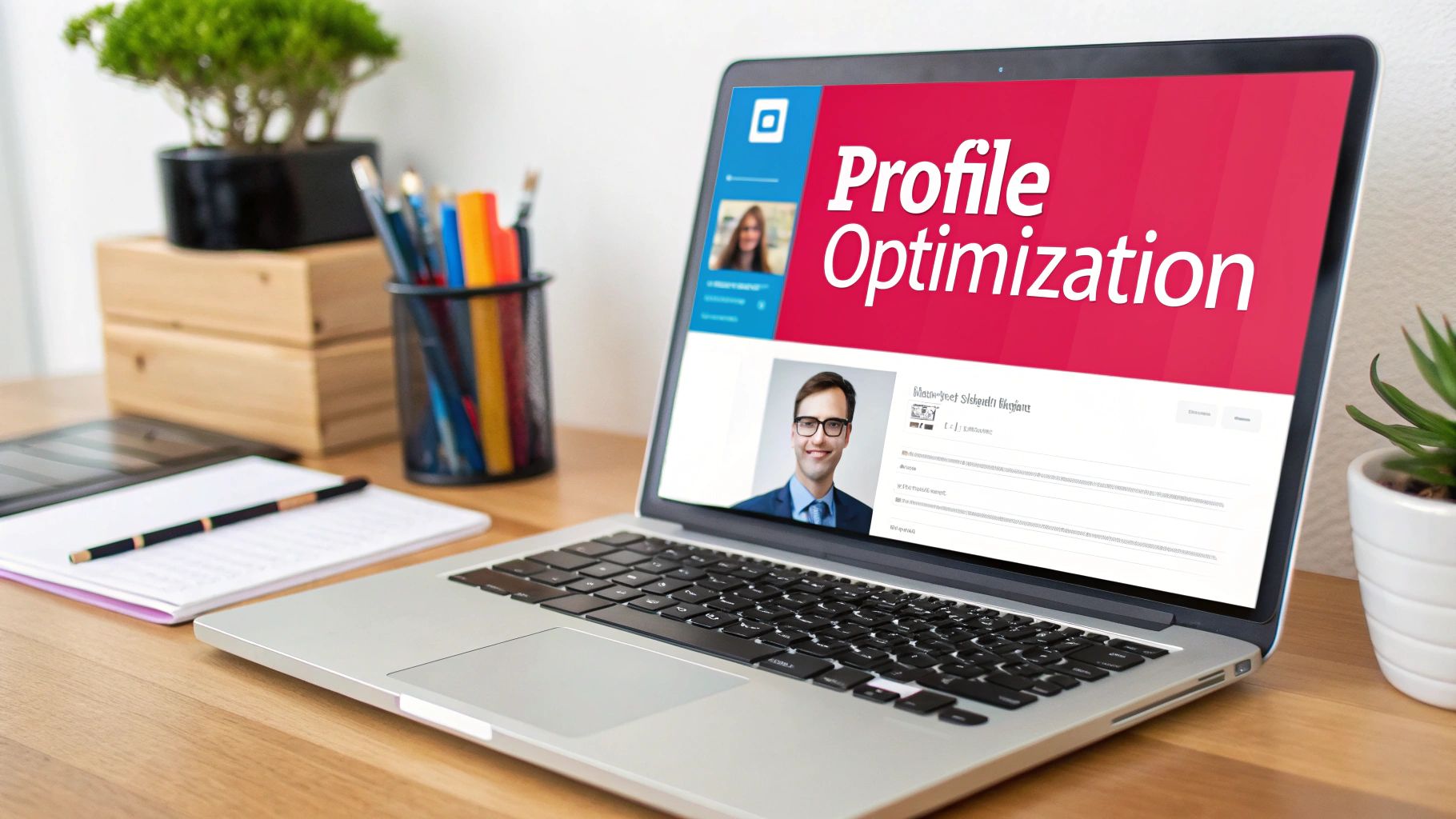
Take a look at Bill Gates' profile. It's a masterclass in clarity. Every single element, from his banner to his headline, works together to project a powerful, mission-driven brand that goes way beyond a simple job title.
Craft a Client-Focused Headline
Your headline is the most valuable piece of real estate on your entire profile. Don't waste it with a generic title like "CEO at Company X." Instead, turn it into a compelling value proposition that answers a prospect's unspoken question: "What's in it for me?"
For example, a marketing consultant could swap out "Marketing Consultant" for something like, "I Help B2B Tech Startups Generate Qualified Leads with Content Marketing." See the difference? It's specific, it names the audience, and it promises a tangible result.
Design a Compelling Banner Image
That default blue banner is a massive missed opportunity. Your banner should be a billboard for your brand, shouting your core message from the rooftops. Use this space to:
- Display your company's tagline or mission.
- Feature a powerful client testimonial or logos of companies you've helped.
- Visually represent the transformation you deliver for your clients.
A custom banner adds instant professionalism and sets you apart from the millions of people who don't bother with this simple but effective branding tool.
Write an 'About' Section That Sells a Solution
Your 'About' section is where you tell your story. Don't just copy and paste your resume here—that's a huge mistake. Instead, structure it to guide a prospect on a journey. Kick things off with a hook that grabs them by addressing their main frustration.
Something like: "Struggling to get your SaaS product in front of enterprise decision-makers?"
From there, briefly walk them through your process and how you solve that exact problem. I always recommend using bullet points to break up the text and highlight key outcomes or services, making it easy to scan. And most importantly, end with a crystal-clear call-to-action. Tell them exactly what to do next, whether it's booking a call, visiting your site, or sending a connection request.
My Two Cents: Your profile isn't a static document you set and forget. It's a living, breathing sales asset. Treat it with the same strategic care you'd give a landing page or an important email campaign.
Putting in this foundational work is so critical because it primes your audience for everything that comes next. Here's a powerful stat: audiences exposed to both branding and acquisition messages on LinkedIn are six times more likely to convert. Your profile is the branding piece that makes your outreach (the acquisition message) exponentially more effective.
By dialing in these core elements—your headline, banner, and 'About' section—you're laying a powerful foundation for your entire B2B LinkedIn strategy. For a deeper dive into this, check out this excellent guide on optimizing your LinkedIn profile for lead generation. Getting this right ensures that when prospects land on your page, they don't just see a resume; they see a solution.
Find Your Ideal B2B Customers on LinkedIn
A polished profile is your home base, but what good is it if the right people never see it? True success in B2B lead generation on LinkedIn comes down to one thing: precision. Flinging connection requests at everyone is a surefire way to waste time and look unprofessional.
The game is about moving from a wide, messy net to a sharp, accurate spear. You need to pinpoint the exact people inside specific companies who not only have the authority to buy but also a genuine need for what you’re selling. It’s all about focusing your energy where it will actually make a difference.
Define Your Ideal Customer Before You Search
Stop. Before you even think about typing in that search bar, you need an absolutely clear picture of who you're hunting for. This is your Ideal Customer Profile (ICP), and without it, you're just navigating in the dark.
A solid ICP is more than just basic demographics. It’s a detailed blueprint of the perfect company you want to land. I always start by thinking through:
- Industry: Which sectors truly feel the pain you solve? Get specific. Is it FinTech, B2B SaaS, or maybe industrial manufacturing?
- Company Size: Are you built for scrappy startups of 10-50 employees or complex enterprises with over 1,000? Their problems, budgets, and buying cycles are worlds apart.
- Geography: Where are these companies? This is non-negotiable for many service businesses but also helps focus your efforts even if you're global.
- Recent Company Activity: This is a big one. Are they hiring developers? Did they just land a new round of funding? These are huge buying signals.
Once you know the type of company, you have to find the right people inside. Don't just aim for the CEO. Think about other key players who influence the decision, like VPs, Directors, or Heads of specific departments (e.g., Head of Marketing, Director of Operations).
A Quick Tip: I always build a "Top 100" target account list based on my ICP. This becomes my North Star for everything—outreach, content engagement, relationship building. It keeps me focused and stops me from chasing shiny objects that don't fit the bill.
Master Advanced Search with Sales Navigator
While LinkedIn’s free search has its uses, for anyone serious about B2B prospecting, LinkedIn Sales Navigator is non-negotiable. It’s the difference between a paper map and a real-time GPS with live traffic updates. It turns a basic search into a surgical operation, letting you apply your ICP with incredible accuracy.
The real magic is in its advanced filters. You can stack criteria on top of each other to create incredibly specific lead lists.
Let's say you're a marketing agency targeting UK-based SaaS companies. Your search could be dialed in like this:
- Geography: United Kingdom
- Industry: Computer Software
- Company Headcount: 51-200 employees
- Seniority Level: Director, VP, C-Suite
- Function: Marketing, Sales
- Keywords in Profile: "Demand Generation" OR "Lead Generation"
Just like that, you've filtered millions of users down to a manageable, high-value list of prospects. Every connection request you send from this list is grounded in real, strategic purpose.
This handy visual breaks down the flow from finding your targets to actually turning them into leads.
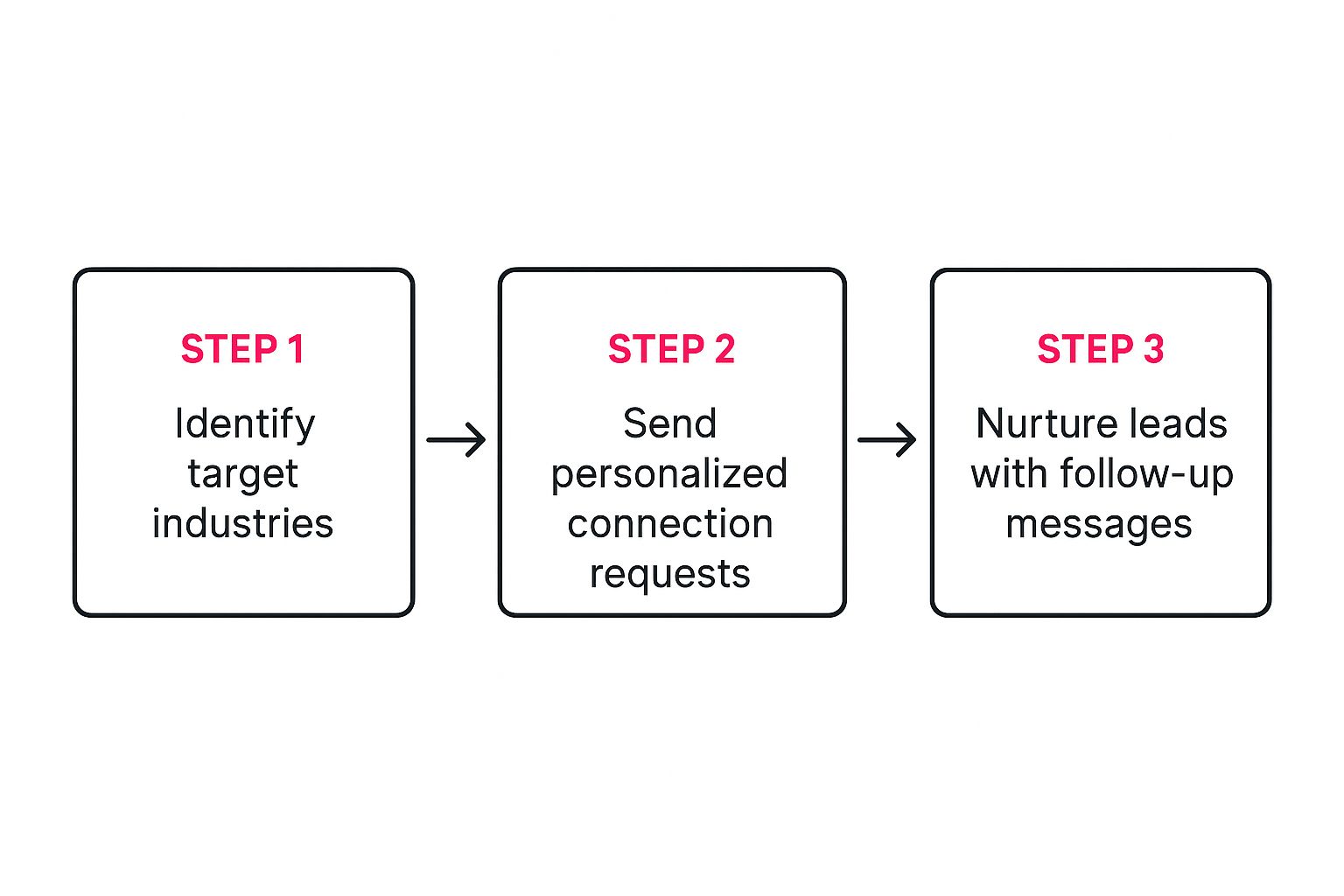
As you can see, it's not just about finding names. It’s a deliberate process that flows from smart identification to personalized engagement and, eventually, long-term nurturing.
Find Engaged Prospects in Groups and Competitor Networks
Sometimes the best prospects aren't found through a direct search; they're hiding in plain sight. Two of my favorite honey pots are LinkedIn Groups and the comment sections of my competitors' posts.
LinkedIn Groups in your niche are full of professionals openly discussing their biggest challenges. Join these groups, but don't pitch. Instead, show up and be genuinely helpful. When you spot active members who fit your ICP, you can engage with their posts or send a highly personalized connection request referencing your shared group.
Similarly, pay close attention to the people engaging with your competitors' content. If someone is liking or commenting on a competitor's post about a problem you solve, they've literally raised their hand and announced their interest. They are a pre-qualified lead. You can then reach out with a message that acknowledges their interest and offers a unique perspective or a bit of extra value they didn't get from your competitor.
Write Messages That People Actually Reply To
This is the moment of truth. You’ve polished your profile and built a rock-solid prospect list, but none of that matters if your first message falls flat. If your outreach gets ignored or—even worse—marked as spam, the whole effort was for nothing. The secret? Stop selling and start a conversation.
Let’s be real: generic, self-serving templates are dead. Your goal is to craft a message that feels less like a cold pitch and more like a genuine, helpful introduction from one professional to another. This isn't just a nice-to-have anymore. With 89% of B2B marketers using LinkedIn for lead generation, standing out is mandatory. You have to cut through an incredible amount of noise.
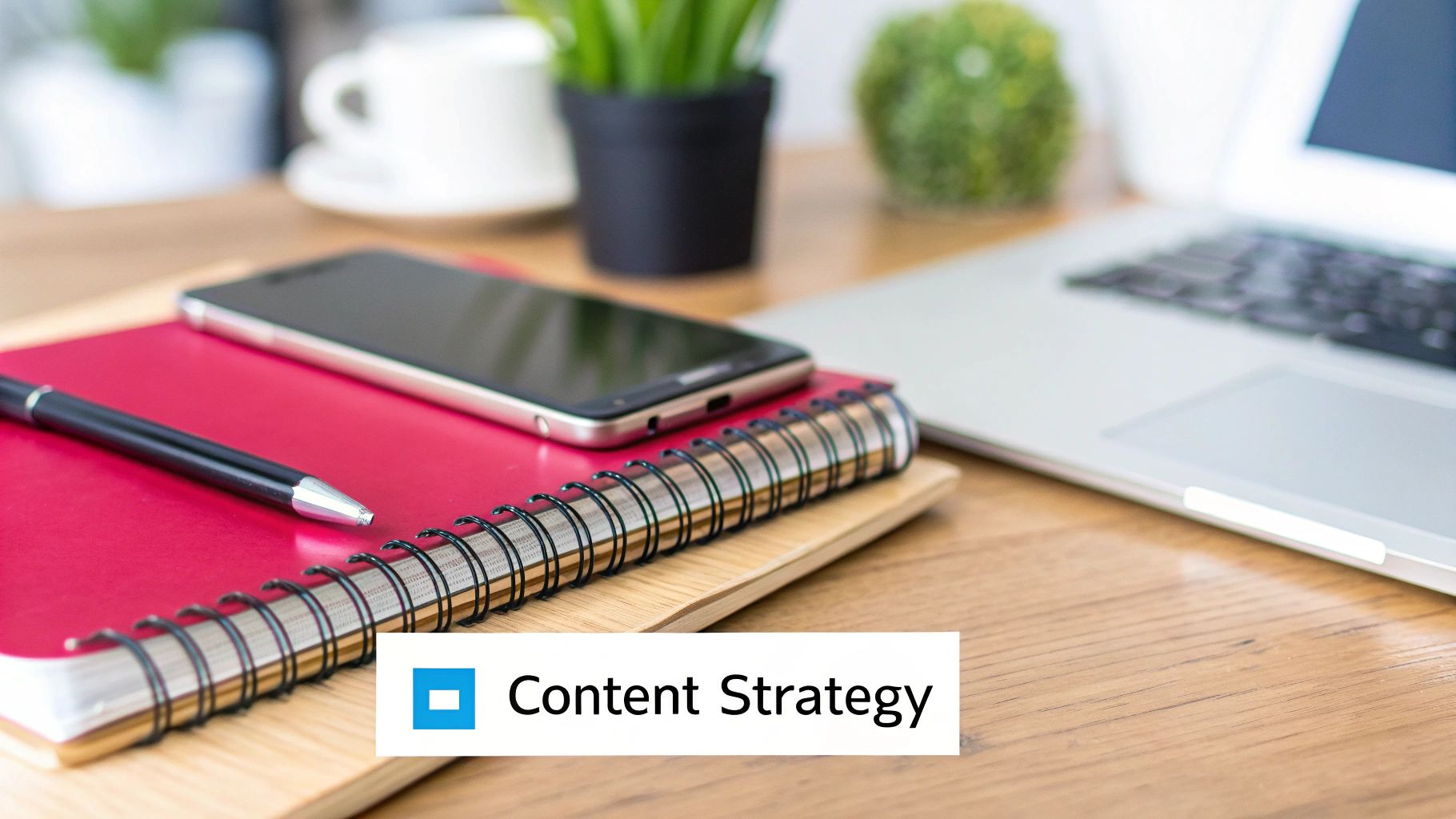
Start With a Compelling Connection Request
That 300-character limit on LinkedIn connection requests? It’s a feature, not a bug. It forces you to be brief and get right to the point. Whatever you do, never send a blank request. That’s the digital equivalent of walking up to someone at a conference, shoving a business card in their hand, and walking away without a word. Awkward and ineffective.
Your note needs to immediately show them why you're reaching out to them specifically. Give them some context.
- Reference a shared connection: "Hi [Name], I see we both know Jane Doe. I've always admired her marketing work, and I noticed you're leading the team over at [Company]. Would love to connect."
- Mention their recent activity: "Hi [Name], your recent post on the challenges of scaling a sales team really hit home—your point about culture was spot on. I’d love to connect and follow your insights."
- Acknowledge a company win: "Hi [Name], saw that [Company] was just featured in TechCrunch for your latest funding round. Huge congrats! Would be great to connect and watch your growth."
The key is making it about them, not you. This simple act of paying attention will dramatically boost your acceptance rate and set a much more positive tone for whatever comes next.
Craft a Value-First Follow-Up Message
So, they accepted your request. Great. The clock is ticking, but this is not the time to pitch. The single biggest mistake I see people make is sending an immediate follow-up that screams, "Thanks for letting me in, now let me tell you what I'm selling!"
Don't be that person.
Instead, your first message after connecting should simply continue the conversation and offer some kind of value with zero strings attached. Thank them for connecting, and then give them something useful based on the homework you did.
Let's walk through an example.
Imagine you're targeting a Head of Marketing at a growing FinTech company. Your follow-up could be something like this:
"Thanks for connecting, [Name]. Following up on my note, I just read this insightful article on customer acquisition trends in the FinTech space and thought you might find it interesting. No pitch, just figured it was a great read. Cheers!"
This approach immediately positions you as a helpful resource, not just another salesperson lining up in their inbox. You're building rapport and earning the right to have a business conversation down the road.
Nurture the Connection With a Smart Cadence
Not everyone is going to reply to your first message, and that's perfectly fine. A good follow-up plan is essential, but there’s a thin line between being persistent and being annoying. I've found a simple, multi-touch sequence spaced out over a couple of weeks works best.
- Touch 1 (Day 1): The initial value-add message right after they connect.
- Touch 2 (Day 5): Don't just message—engage. Go find one of their recent posts and leave a thoughtful comment. This keeps you on their radar without clogging their DMs.
- Touch 3 (Day 10): Now you can send a final, gentle follow-up. This is your chance to subtly pivot toward a business context. You could try, "Hi [Name], hope you're having a productive week. The reason I'm reaching out is that we often help FinTech marketing leaders like you solve [specific problem]. Is this a priority for you right now?"
This multi-channel approach mirrors what works in other forms of outreach. In fact, many of the core principles of personalization and value apply across all platforms, which you can see in our guide on B2B lead generation via email.
Create Content That Pulls Inbound Leads to You
While targeted outreach is great for getting your foot in the door, a smart content strategy is what blows that door wide open. When you create and share genuinely useful content, your LinkedIn profile stops being a static resume and becomes a magnet for inbound leads. This isn't about posting just for the sake of it; it's about strategically positioning yourself as an authority and pulling your ideal clients toward you.
The goal is to flip the script. Stop being the hunter all the time and let yourself become the hunted. By consistently delivering value, you build trust and stay top-of-mind. When a prospect finally realizes they have a problem you can solve, you'll be the first person they think of because you’ve already proven you understand their world.
Shift Your Mindset from Pitching to Teaching
The most effective content on LinkedIn doesn't sell—it teaches. Let's be honest, prospects are bombarded with sales pitches constantly. What they're really hungry for are insights that can help them excel at their jobs. Your content should aim to solve a small piece of their problem for free, which builds incredible goodwill and showcases your expertise without being pushy.
Think about the most common questions your clients ask. What are those "aha!" moments they experience when you work with them? Those are pure gold for LinkedIn content.
Here are a few content pillars that I've seen work exceptionally well in the B2B space:
- Problem/Solution Posts: Clearly spell out a common industry pain point. Then, walk your audience through a practical framework or a quick tip to start addressing it.
- Contrarian Takes: Don't be afraid to respectfully challenge a common assumption or a so-called "best practice" in your field. This shows you're a critical thinker and is fantastic for sparking conversations.
- Data-Driven Insights: Found a surprising statistic or a key finding from a recent report? Share it, but more importantly, explain what it actually means for your audience and their business.
This approach is all about building credibility. With 40% of LinkedIn visitors engaging with a Page organically each week, a consistent, value-first strategy is how you capture that attention without spending a single dollar on ads.
Master the Right Content Formats for LinkedIn
Not all content gets the same love on LinkedIn. The platform's algorithm and user habits definitely favor certain formats over others. While you should always experiment to see what resonates with your specific audience, some formats are proven winners for B2B lead generation.
For example, I've seen simple text-only posts with a killer hook and plenty of white space perform incredibly well. They feel personal and are super easy for people to read on the go. Another powerhouse is the document post (often called a carousel). These allow you to take slides from a presentation or pages from a guide and turn them into a visually engaging, swipeable story.
My Biggest Tip: Never just post and ghost. The first hour after you publish is absolutely critical. Make a point to stick around and reply to every single comment. This immediate engagement sends a powerful signal to the LinkedIn algorithm that your content is valuable, which helps push it out to a much wider audience.
To help you decide what to create, here’s a quick breakdown of how different content types typically perform for B2B audiences.
LinkedIn Content Type Performance Comparison
| Content Type | Primary Goal | Best For | Average Engagement Rate |
|---|---|---|---|
| Text-Only Post | Sparking conversation, sharing quick insights | Personal stories, questions, contrarian takes | High |
| Image Post | Grabbing attention, brand reinforcement | Infographics, quotes, team photos, event announcements | Medium |
| Video Post | Building connection, demonstrating expertise | How-to guides, interviews, behind-the-scenes looks | High |
| Carousel/Doc Post | Educating in-depth, showcasing value | Repurposed presentations, guides, step-by-step tutorials | Very High |
| Poll | Gathering audience feedback, boosting reach | Quick market research, engaging on topical issues | Medium-High |
As you can see, carousels and videos often lead the pack for deep engagement, but a well-crafted text post can be just as powerful for starting a meaningful dialogue. Beyond just posting on your profile, it's about a holistic strategy. For more great ideas, you can explore various social media content ideas to boost engagement that can be adapted for LinkedIn.
Repurpose Your Existing Assets—Don't Reinvent the Wheel
You don't need to create something from scratch every single day. Your company is likely sitting on a goldmine of existing long-form content, from blog posts and case studies to webinars and whitepapers. The real trick is learning how to "atomize" these big assets into dozens of bite-sized LinkedIn updates.
This is a fundamental tactic in smart social media marketing for startups because it gives you the best possible return on the time and effort you've already invested in creating that content.
Here’s a real-world example of how this works:
- You start with one asset: Let's say you just hosted a one-hour webinar on "How to Scale Sales Teams."
- Pull out the best quotes: Go through the transcript and pull 5-7 of the most powerful one-liners from the speaker. Each one of those can be a text post or an image quote.
- Clip short videos: Edit the webinar recording into 3-5 short video clips. Each clip should focus on a single, impactful tip that can stand on its own.
- Create a carousel: Take the main presentation slides and save them as a PDF. Upload that as a carousel post that summarizes the webinar's key takeaways.
- Write summary posts: Author several text-only posts, each diving a little deeper into one specific concept you discussed during the webinar.
Just like that, you've turned one hour of effort into several weeks' worth of high-value content. This consistent rhythm of sharing, asking smart questions, and participating in conversations is what keeps you visible and valuable to the people you want to attract.
Measure What Matters to Improve Your Results
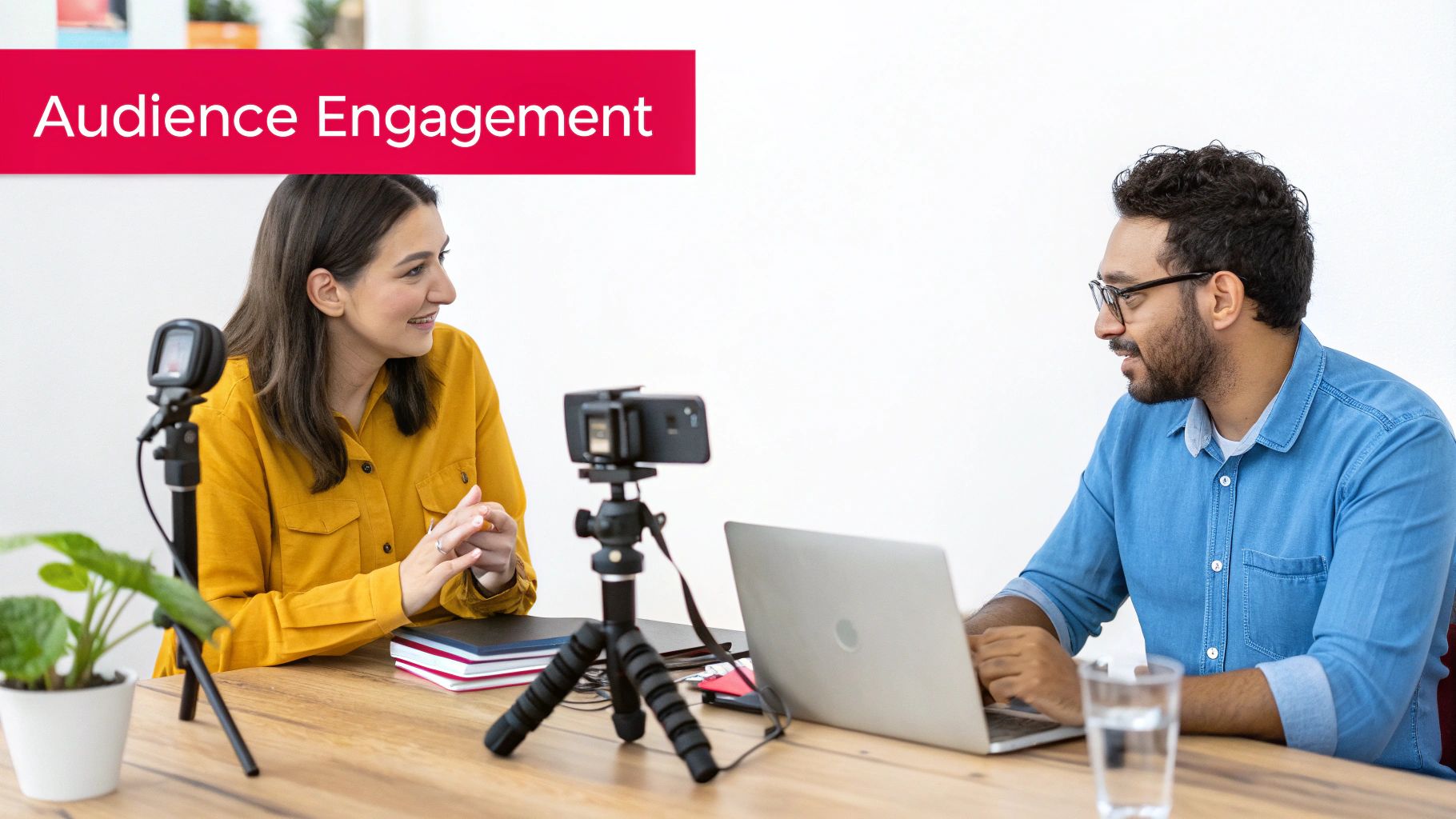
If you're not tracking your performance, you're not running a strategy; you're just guessing. Effective B2B lead generation on LinkedIn isn't about random acts of outreach. It’s a deliberate process you can measure, analyze, and constantly improve. Without data, you’re flying blind, with no real idea of what’s working and what’s just wasting your time.
It’s easy to get distracted by "vanity metrics" like likes, shares, or your follower count. Sure, they feel good, but they don’t tell you if your efforts are actually creating business opportunities. To turn your LinkedIn activity into a reliable growth engine, you have to focus on the key performance indicators (KPIs) that truly matter.
Moving Beyond Vanity Metrics
The real objective is to track metrics that show tangible progress through your sales funnel. These are the numbers that reveal whether your targeting is sharp, your messaging is compelling, and your offers are hitting the mark.
Here are the essential KPIs you should be watching like a hawk for any B2B LinkedIn campaign:
- Connection Acceptance Rate: This is your first major hurdle. It's simply (Accepted Requests / Total Requests Sent) x 100. A low rate, say below 20-30%, is a clear signal. It usually means your connection note isn't personalized enough or you’re reaching out to the wrong audience entirely.
- Message Reply Rate: Once you connect, how many people actually engage with you? Calculated as (Replies Received / Total First Messages Sent) x 100, this metric directly reflects how relevant and interesting your first follow-up message is.
- Positive Reply Rate: Let's be honest, not all replies are created equal. A "Thanks, but no thanks" is worlds away from, "This sounds interesting, can you tell me more?" Tracking the percentage of positive or neutral replies helps you understand how well your value proposition is actually landing.
- Meetings Booked: This is the ultimate bottom-line metric. How many of your conversations are turning into a scheduled call or demo? This KPI is the bridge that connects your LinkedIn activity directly to your sales pipeline.
By zeroing in on these core numbers, you stop hoping for results and start engineering them.
Building Your Tracking System
You don't need a complicated or expensive system to get started. A simple spreadsheet is often more than enough to get going. This small step provides immense clarity and is a cornerstone of any effective marketing campaign tracking.
Set up columns for each of your key metrics. I find tracking this weekly is the sweet spot for spotting trends without getting bogged down in daily fluctuations.
| Metric | Week 1 | Week 2 | Week 3 | Week 4 | Monthly Avg. |
|---|---|---|---|---|---|
| Connections Sent | 100 | 100 | 100 | 100 | 400 |
| Accepted Requests | 35 | 42 | 38 | 45 | 160 |
| Acceptance Rate (%) | 35% | 42% | 38% | 45% | 40% |
| Replies Received | 14 | 21 | 19 | 25 | 79 |
| Meetings Booked | 2 | 4 | 3 | 5 | 14 |
This simple dashboard immediately shows you how your efforts are paying off and where you might need to make adjustments.
Key Insight: Don't just collect the data—interrogate it. If your acceptance rate is high but your reply rate is dismal, the problem isn't your targeting; it's your first message. This data-driven approach lets you diagnose problems with surgical precision.
Using Data to Refine and A/B Test
Once you have a tracking system in place, you can finally start making informed decisions. The real power comes from A/B testing—running two different versions of a message or targeting strategy to see which one performs better.
For example, you could test two different connection request notes. Send Version A to 50 prospects and Version B to another 50. Track the acceptance rate for both. Whichever one wins becomes your new control, and you test a new challenger against it. This cycle of continuous improvement is what separates the pros from the amateurs.
This same logic applies to your content and even paid ads. Did you know that LinkedIn ads often have a cost per lead that is 28% lower than Google Ads and can achieve conversion rates 2x higher than other channels? By tracking your own CPL and conversion rates, you can benchmark your performance and optimize your spend for the best possible return.
Adopting this analytical mindset transforms B2B LinkedIn lead generation from an unpredictable art form into a predictable science for growing your business.
Common Questions About LinkedIn Lead Generation
https://www.youtube.com/embed/DXX45_RWxeg
Even with a great plan, you're bound to run into questions and roadblocks when generating leads on LinkedIn. It happens to everyone. The real secret is knowing how to navigate these common sticking points—it's often what separates a stalled campaign from one that’s firing on all cylinders.
Getting these details right is crucial. After all, 46% of social media traffic to company websites comes from LinkedIn, and a staggering 80% of all B2B leads from social media originate here. Getting the little things right can completely change your results.
How Many Connection Requests Should I Send Per Day?
I see this question all the time, and my answer always surprises people: it’s about quality, not quantity. Instead of blasting out as many requests as you can, aim for 10-15 highly personalized connection requests each day. This approach keeps your account safe from LinkedIn's limits and, more importantly, gets you much better results.
Think about it from their perspective. A thoughtful note that shows you’ve done your homework is far more compelling than a generic template. The goal isn't just to rack up connections; it's to build a valuable network of people you can actually do business with.
What Is the Biggest Mistake in Outreach Messages?
Hands down, the biggest and most common mistake is pitching your product or service right after someone accepts your connection request. It’s an instant turn-off. You immediately come across as just another salesperson trying to hit a quota, and that’s a fast track to being ignored or removed.
Your first few messages should be about starting a genuine conversation and building a little rapport. Lead with value, always. Focus on their world—comment on their recent posts, mention their company's latest news, or ask about a challenge in their industry. When you offer a helpful insight first, you earn the right to talk about business later.
"The goal of the initial outreach is to start a conversation, not to close a deal. Focus on personalization, relevance, and offering value first."
This simple mental shift—from selling to helping—is the bedrock of any successful LinkedIn lead generation effort.
Is LinkedIn Sales Navigator Really Worth the Cost?
For anyone who's serious about B2B lead generation on LinkedIn, the answer is an absolute, unqualified yes. The free version is fine for basic networking, but Sales Navigator is a completely different tool built from the ground up for precision prospecting.
The advanced lead and account filters are game-changers. You can build incredibly specific prospect lists based on criteria like company growth rate, seniority level, or even keywords mentioned in their profile. You also get features like saved searches and critical account insights that are impossible to get otherwise. If just one deal you close pays for the entire year's subscription, the ROI speaks for itself.
How Long Should I Wait Before Following Up?
Patience is key here. As a general rule of thumb, wait 3-5 business days before sending a follow-up. This gives your prospect plenty of time to see your first message without feeling like you're hovering over their inbox.
And when you do follow up, please avoid the lazy "just checking in" or "bumping this up" message. It adds no value. Instead, treat the follow-up as another chance to be helpful.
- Share a link to a different, but still relevant, article.
- Comment on a recent post they shared to spark a new, natural conversation.
- Offer a quick, useful tip related to a problem their industry is currently facing.
This strategy keeps you on their radar in a positive way and makes a reply much more likely. For a deeper dive into more tactics, I'd recommend checking out these 8 proven LinkedIn lead generation strategies that can really boost your efforts.
Ready to turn these ideas into a steady stream of high-quality leads? At Grassroots Creative Agency, we live and breathe this stuff. We build and run data-driven B2B lead generation strategies that get real, measurable results. Let us handle the complexities of LinkedIn so you can focus on closing deals. Book a consultation with us today!
